Long March 9: China’s Super-Heavy Ambitions
14th Dec 2023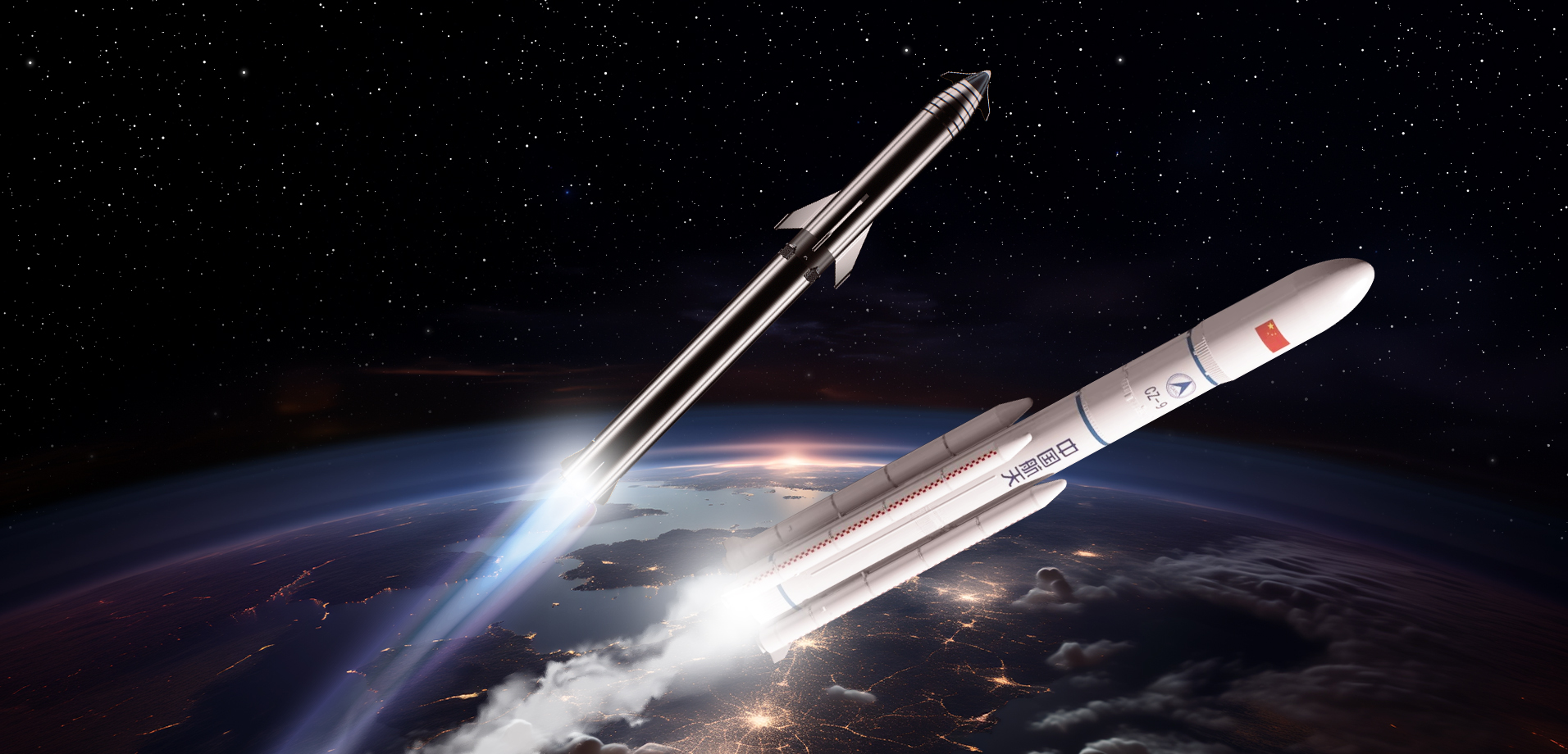
The Chinese space program has been making significant strides in recent years, and the development of the Long March super-heavy carrier rocket series stands out for its potential to revolutionize space exploration.
China has long been dropping hints about developing its Long March 9 (CZ-9) rocket, a much-anticipated three-stage super-heavy variant within the Long March family. Much like SpaceX’s Starship launch system, it will be fully reusable, driving down the cost of successive missions.
Reports suggest this launch vehicle will boast an impressive capacity, carrying payloads of up to 150,000 kg (165 tons) to Low Earth Orbit (LEO) and 54,000 kg (59.5 tons) to a trans-lunar injection. On 2nd March, the China Academy of Launch Vehicle Technology (CALT) confirmed the completion of the inaugural propellant tank for the Long March 9. So, how might the rocker’s fully reusable design echo SpaceX’s Starship and impact the economics of space travel? Let’s dive deep into it!
Exploring the Long March Series
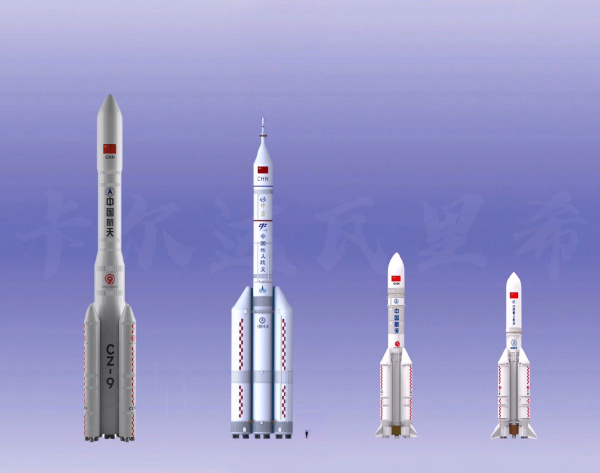
Originating in the early 1970s, the Long March rockets have undergone significant iterations, showcasing China’s dedication to space exploration. The series encompasses eight versions thus far, with each designed for specific objectives such as satellite launches, lunar missions, and crewed spaceflights.
Why are Chinese Rockets Called Long March?
The terminology “Long March” is deeply rooted in Chinese history, harking back to the extensive military retreat of the Red Army in the 1930s. This symbolism aligns with space exploration’s arduous and ambitious nature, where perseverance and determination echo the spirit of the historical Long March.
The Long March Rocket Family
The Long March is China’s primary expendable launch system family. Not only has it been pivotal in military operations, with the Shenzhou spacecraft launched on the Long March rocket, but it has also played a crucial role in space exploration. Over the years, China has developed a second-generation family of launchers that include LM-5, LM-6, and LM-7. Unlike their predecessors, these launchers are not based on Intercontinental Ballistic Missiles (ICBMs).
A prominent member of the Long March family is the Long March 5. As of 31st October 2022, rockets in the Long March 5 family had been part of nine launches. Out of these, eight were successful, with a single failure. The Long March 8, the latest addition to the Long March family, marked the 356th flight of the Long March rocket family.
The New Titan: Long March 9
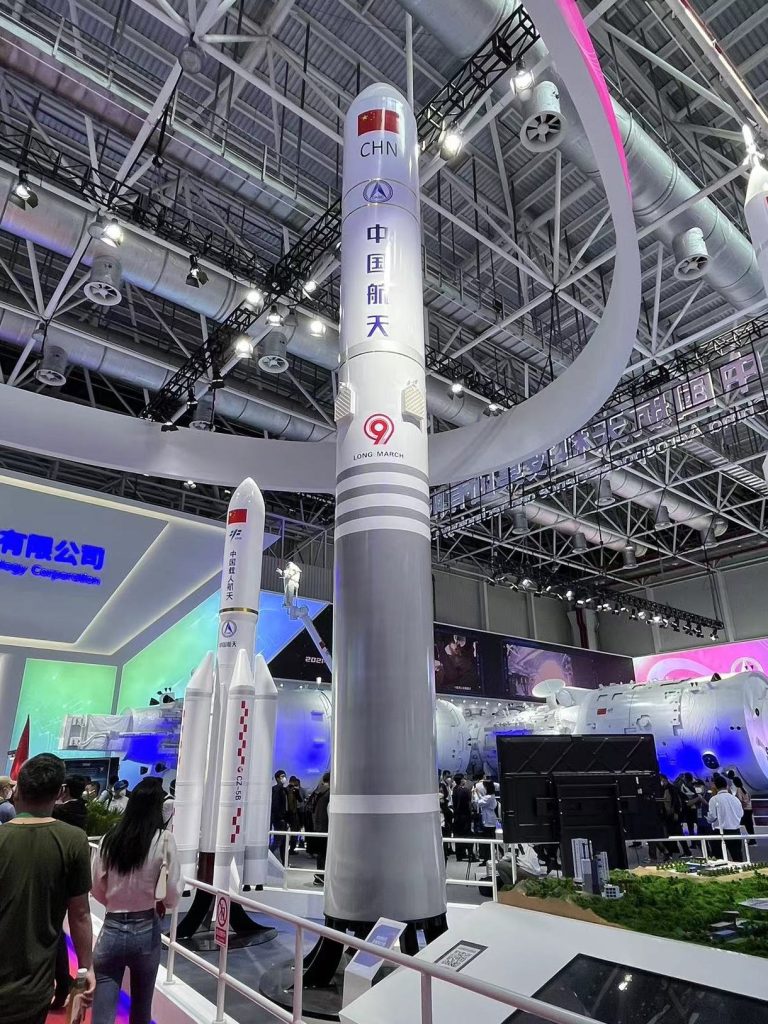
With the Long March 9 China seeks to extend this lineup. Chinese super-heavy carrier rocket concept proposed in 2018 is currently under study. With its massive size and immense power, the Long March 9 is poised to be a game-changer for China’s space program.
China has set its sights on 2033 for the inaugural launches of a three-stage Long March rocket, propelled by an array of full-flow staged combustion methane engines on its primary stage. This technological marvel boasts a payload capacity of 50 tons to lunar transfer orbit, with the added advantage of hauling 35 tons when the first stage is salvaged.
The rocket is being developed by the China Academy of Launch Vehicle Technology (CALT). The initial version will be 114 meters long, have a mass at liftoff of 4,400 tons and generate 6,100 tons of thrust.
Looking ahead, the pinnacle aspiration lies in a fully reusable model boasting an 80-ton payload capacity to LEO. Anticipated to take flight in the early 2040s, this variant represents the ultimate objective of this remarkable endeavor. The future Long March 9 is poised to be pivotal in deploying components for a space-based solar power station in geostationary orbit. While reusable super heavy-lift rockets have the potential to significantly reduce associated launch costs, resolving various technical, engineering, and financial challenges remains imperative for the success of this venture.
Is China Long March 9 reusable?
Originally, Long March 9 was planned as an expendable rocket. However, since 2016, this rocket has seen a radical shift in design and is now being developed as a fully reusable rocket, as per an official announcement by China on 24th April during its Spaceflight Day celebrations.
The decision to transition from an expendable model to a reusable one mirrors a global rocket design trend driven by economic and environmental considerations. The shift towards reusability can drastically reduce the cost of space travel, as it eliminates the need to manufacture a new rocket for each launch.
How Much Will the Long March 9 Cost?
The cost of the Long March 9, a Chinese super-heavy carrier rocket rocket currently under development in China, has not been explicitly stated. However, the drive towards reusability of this rocket could make the associated launch costs much more manageable.
An average Long March rocket costs about US$3,000 per kilogram for payload delivery. In comparison, SpaceX’s reusable Falcon 9 rockets have set a competitive pricing precedent in the market. Given the massive lift capacity of the Long March 9, the cost per kilogram to low Earth orbit (LEO) could range between $1,500 and $2,500.
Starship vs Long March: What Is the Difference?
Comparisons between the Long March 9 and SpaceX’s Starship are inevitable. Both are super-heavy rockets designed for ambitious space missions. However, there are some key differences.
While Starship is designed to be fully reusable from the outset, the Long March 9 is currently a concept under development, with full reusability planned for future iterations.
While SpaceX’s Starship has encountered delays in its launch schedules, its relentless pursuit of innovation has continually pushed boundaries, setting unprecedented benchmarks in the space industry. Despite regulatory hurdles, SpaceX’s agile “fail fast, learn fast” methodology fosters rapid enhancements in design, positioning Starship for imminent crewed missions. In contrast, China’s Long March 9, earmarked for a 2033 debut, embarks on a more gradual trajectory. Its initial iteration will feature a reusable first stage, propelling 35 tons to lunar transfer orbit. Notably, a fully reusable variant of the Long March 9 isn’t projected to soar until around 2040, promising an 80-ton payload to LEO.
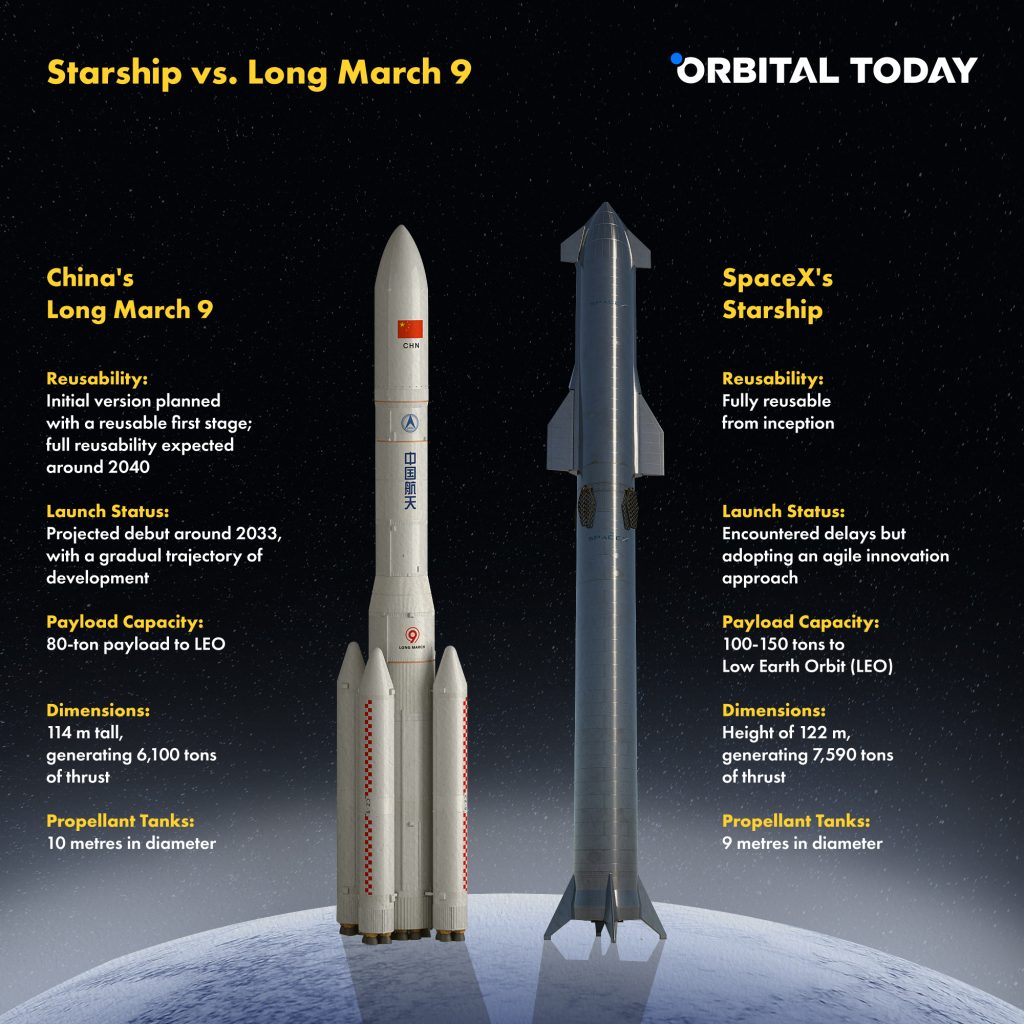
Regarding payload capacity, Starship anticipates a 100-150 ton LEO capacity once fully operational. Standing at 120 meters tall and generating 7,590 tons of liftoff thrust via next-gen Raptor engines, Starship’s prowess prevails. In comparison, the initial 114-meter-tall Long March 9 generates 6,100 tons of thrust.
The propellant tank of Long March 9, stretching 10 meters in diameter, stands as China’s most extensively developed tank to date. Surpassing the dimensions of SpaceX’s Starship main propellant tanks (9 m, 30 ft) and NASA’s Space Launch System (8.4 m, 27.5 ft), it boasts a slightly wider profile. Comparatively, it’s twice the size of the initial stage of the Long March 5 rocket, presently the linchpin of the China National Space Agency’s (CNSA) missions. This feat marks a significant engineering accomplishment, laying robust groundwork for the evolution and construction of formidable launch vehicles.
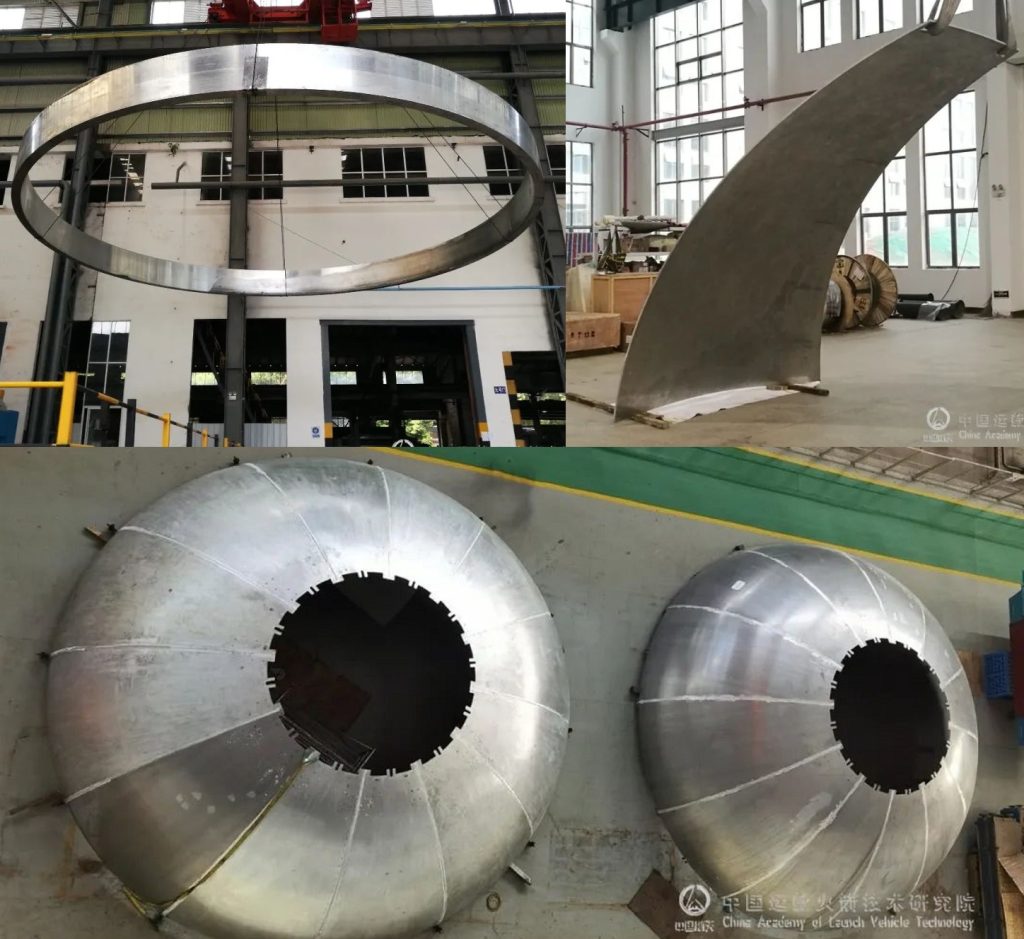
China’s amendments to Long March 9’s design might impede its International Lunar Research Station (ILRS) aspirations, competing against NASA’s lunar Gateway project. However, China anticipates the advantages of a fully reusable launch system to outweigh potential delays.
Additionally, China’s Long March 10, slated for a 2027 maiden voyage, aligns with ambitious lunar landing plans before 2030, showcasing China’s multifaceted strides in space exploration. This strategic shift mirrors China’s broader ambition to assert itself as a spacefaring superpower on par with NASA.






Thank you for your comment! It will be visible on the site after moderation.